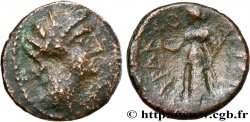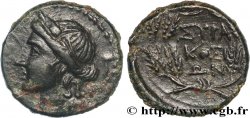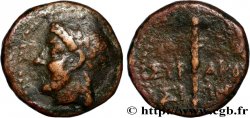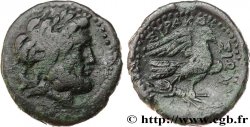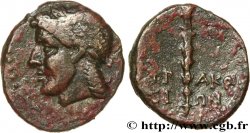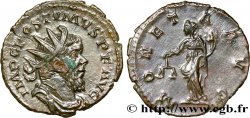You must signin and be an approved bidder to bid, LOGIN TO BID. Accounts are subject to approval and the approval process takes place within 48 hours. Do not wait until the day a sale closes to register. Clicking on « bid » constitutes acceptance of the terms of use of cgb.fr private e-auctions.
Bids must be placed in whole Euro amounts only. The sale will start closing at the time stated on the item description; any bids received at the site after the closing time will not be executed. Transmission times may vary and bids could be rejected if you wait until the last second. For further information ckeck the E-auctions F.A.Q.
NO BUYER'S FEE.
NO BUYER'S FEE.
| Estimate : | 150 € |
| Price : | 67 € |
| Maximum bid : | 100 € |
| End of the sale : | 28 October 2019 14:03:30 |
| bidders : | 16 bidders |
Type : Tetras
Date: c. après 212 AC.
Mint name / Town : Syracuse, Sicile
Metal : bronze
Diameter : 16,5 mm
Orientation dies : 11 h.
Weight : 2,65 g.
Rarity : R2
Coments on the condition:
Exemplaire sur un petit flan ovale bien centré à l’usure régulière, lisible et identifiable. Patine marron
Catalogue references :
Obverse
Obverse legend : ANÉPIGRAPHE.
Obverse description : Tête de nymphe à droite, les cheveux couronnés de roseau ; derrière la tête, un petit dauphin.
Reverse
Reverse description : Légende en trois lignes dans une couronne composite.
Reverse legend : SURA/KOSI/WN
Reverse translation : (de Syracuse).
Commentary
Pour O. Hoover, ce type serait fabriqué au IIe siècle avant J.-C. Il s’agit bien d’une divinité marine et pas d’Apollon à cause du petit dauphin placé derrière la tête.
For O. Hoover, this type would be made in the 2nd century BC. It is indeed a marine divinity and not Apollo because of the small dolphin placed behind the head
For O. Hoover, this type would be made in the 2nd century BC. It is indeed a marine divinity and not Apollo because of the small dolphin placed behind the head








 Report a mistake
Report a mistake Print the page
Print the page Share my selection
Share my selection Ask a question
Ask a question Consign / sell
Consign / sell
 Full data
Full data